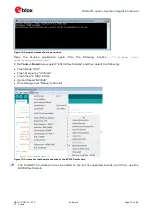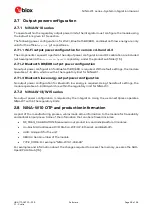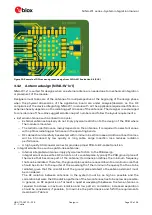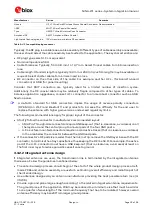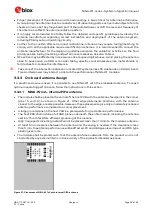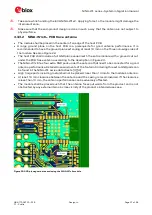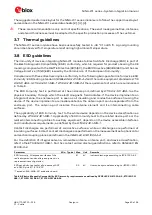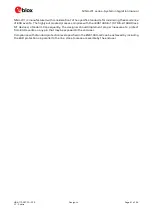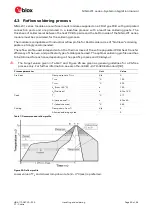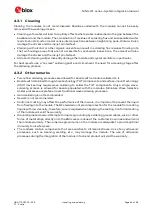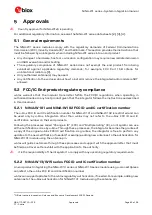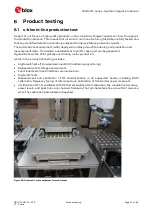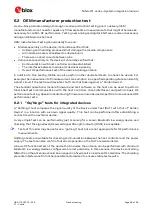
NINA-W1 series - System integration manual
UBX-17005730 - R15
Design-in
Page 40 of 54
C1 - Public
The suggested paste mask layout for the NINA-W1 series modules is to follow the copper mask layout
as described in the NINA-W1 series data sheets [2], [3], [4].
⚠
These are recommendations only and not specifications. The exact mask geometries, distances
and stencil thicknesses must be adapted to the specific production processes of the customer.
3.7
Thermal guidelines
The NINA-W1 series modules have been successfully tested in -40 °C to +85 °C. A good grounding
should be observed for temperature relief during high ambient temperature.
3.8
ESD guidelines
The immunity of devices integrating NINA-W1 modules to Electro-Static Discharge (ESD) is part of
the Electro-Magnetic Compatibility (EMC) conformity, which is required for products bearing the CE
marking, compliant with the R&TTE Directive (99/5/EC), the EMC Directive (89/336/EEC) and the Low
Voltage Directive (73/23/EEC) issued by the Commission of the European Community.
Compliance with these directives implies conformity to the following European Norms for device ESD
immunity: ESD testing standard
CENELEC EN 61000-4-2 and the radio equipment standards ETSI
EN 301 489-1, ETSI EN 301 489-7, ETSI EN 301 489-24, the requirements of which are summarized
in Table 6.
The ESD immunity test is performed at the enclosure port, defined by
ETSI EN 301 489-1 as the
physical boundary through which the electromagnetic field radiates. If the device implements an
integral antenna, the enclosure port is seen as all insulating and conductive surfaces housing the
device. If the device implements a removable antenna, the antenna port can be separated from the
enclosure port. The antenna port includes the antenna element and its interconnecting cable
surfaces.
The applicability of ESD immunity test to the whole device depends on the device classification as
defined by
ETSI EN 301 489-1. Applicability of ESD immunity test to the related device ports or the
related interconnecting cables to auxiliary equipment, depends on the device accessible interfaces
and manufacturer requirements, as defined by the
ETSI EN 301 489-1.
Contact discharges are performed at conductive surfaces, while air discharges are performed at
insulating surfaces. Indirect contact discharges are performed on the measurement setup horizontal
and vertical coupling planes as defined in the
CENELEC EN 61000-4-2.
For the definition of integral antenna, removable antenna, antenna port, and device classification,
refer to the ETSI EN 301 489-1. For the contact and air discharges definitions, refer to CENELEC EN
61000-4-2.
Parameter
Min. Typical Max. Unit Remarks
ESD immunity. All exposed surfaces of the
radio equipment and ancillary equipment in a
representative configuration
8*
kV
Indirect discharge according to IEC 61000-4-2
ESD sensitivity, tested for all pins except ANT
and RSVD pins #11, #15, #33
2.0
kV
Human body model according to JEDEC JS001
* Tested on EVK-NINA-W1 evaluation board.
Table 6: Electro-Magnetic Compatibility ESD immunity requirements as defined by CENELEC EN 61000-4-2, ETSI EN 301
489-1, ETSI EN 301 489-7, ETSI EN 301 489-24


